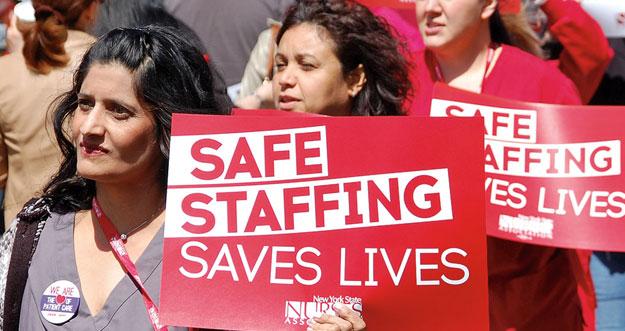Spotlight on staffing: April 16

It was a tremendous day for nurses and patients, a historic show of unity, with thousands of our nurses at 17 New York City and Westchester based facilities in rallies and informational picketing outside their facilities. The unprecedented joint action brought public attention to the urgent need for improved nurse and other caregiver staffing. Nurses know first-hand that staffing levels in several facilities fall far short of those set forth in professional peer-reviewed medical studies. The informational picket was a platform to spread the message that when nurses are assigned to care for too many patients, patients can be at risk.
Top priority
Safe staffing has always been a top priority for our bargaining teams. Eighteen thousand New York City and Westchester NYSNA members are currently negotiating renewals of their contracts. At the day-long pickets, nurse after nurse spoke of rising acuities, being stretched too thin, and the frustration of not having time to give their patients the time and level of care they deserve. Robin Krinksy, RN at Mount Sinai Hospital in Manhattan, explained why nurses are advocating for safe staffing: “We’ve addressed it in practice committees and have staffing guidelines, but they must be enforced.”
Karine Raymond, RN at Montefiore Medical Center’s Weiler Hospital in the Bronx, captured the sentiment of many with this comment: “It’s important for management to understand that when nurses ask for better staffing ratios, it’s not because we want to sit back and eat bonbons. It’s because we’ve seen that patients should not be short changed when there are not enough nurses.” Her colleague Xenia Green, a Pediatric ICU nurse in Montefiore’s Children’s Hospital, added, “No one went to nursing school to be a mediocre nurse. Every nurse wants to be an exemplary one, but understaffing makes it very difficult.”
Safe staffing is win-win
Patients aren’t the only ones that stand to gain from better staffing. With the changes in reimbursement, it could be good for hospitals’ bottom lines, as well. Rhonda Covitz, a New York Presbyterian ICU nurse for 35 years, expressed frustration that hospital management is not acknowledging that nurse staffing will be key to realizing the financial benefits under DSRIP (Delivery System Reform Incentive Program) in the form of rewards for better outcomes, reduced readmissions, and instituting more preventive care. “On the ground, we’re not seeing the changes needed to make this happen. Many in my unit are working 3 or 4 overtime shifts each month, but there are not enough RNs to fill the holes in staffing. I don’t know what the problem is. There are many qualified nurses out there looking for work.”
Five days later, New York City nurses took their message to Albany and joined with NYSNA members from throughout the state to share their concerns on staffing with state legislators and urge passage of the Safe Staffing for Quality Care Act.